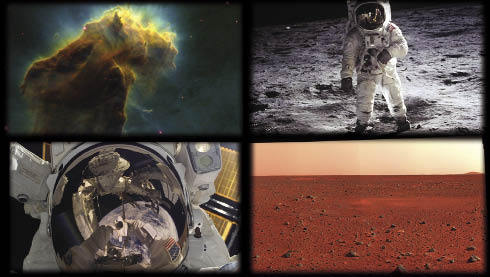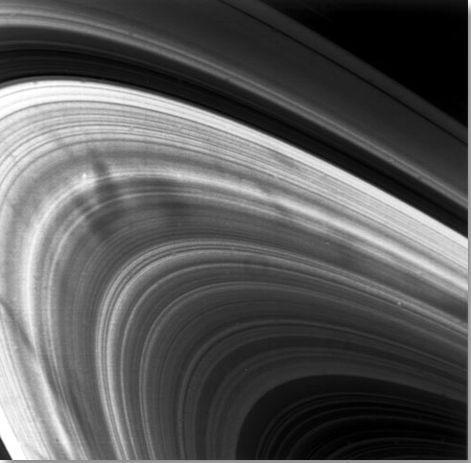10 Out Of This World NASA Spinoff Technologies
10 Out of this World NASA Spinoff Technologies
What is a spinoff? Great question! A NASA spinoff is a technology, originally developed to meet our mission needs that has been transferred to the public and now provides benefits as a commercial product or service. Basically, we create awesome stuff and then share it with the world. Here’s a list of just a few NASA spinoff technologies (in no particular order):
1. Enriched Baby Food

While developing life support for Mars missions, NASA-funded researchers discovered a natural source for an omega-3 fatty acid that plays a key role in infant development. The ingredient has since been infused in more than 99% of infant formula on the market and is helping babies worldwide develop healthy brains, eyes and hearts.
2. Digital Camera Sensors

Whether you take pictures and videos with a DSLR camera, phone or even a GoPro, you’re using NASA technology. The CMOS active pixel sensor in most digital image-capturing devices was invented when we needed to miniaturize cameras for interplanetary missions.
3. Airplane Wing Designs

Did you know that we’re with you when you fly? Key aerodynamic advances made by our researchers - such as the up-turned ends of wings, called “winglets” - are ubiquitous among modern aircraft and have saved many billions of dollars in fuel costs.
4. Precision GPS

Uncorrected GPS data can be off by as much as 15 meters thanks to data errors, drift in satellite clocks and interference from Earth’s atmosphere. One of our software packages developed in the 1990s dials in these locations to within centimeters, enabling highly accurate GPS readings anywhere on the planet. One of our most important contributions to modern society, precise GPS is used in everything from personal devices and commercial airplanes to self-driving tractors.
5. Memory Foam

Possibly the most widely recognized spinoff, memory foam was invented by our researchers looking for ways to keep its test pilots and astronauts comfortable as they experienced extreme acceleration. Today, memory foam cushions beds, chairs, couches, car and motorcycle seats, shoes and even football helmets.
6. International Search and Rescue System

We pioneered the technology now used internationally for search and rescue operations. When pilots, sailors or other travelers and adventurers are stranded, they can activate a personal locator bacon that uses overhead satellites to relay their call for help and precise location to authorities.
7. Improvements to Truck Aerodynamics

Nearly every truck on the road has been shaped by NASA - literally. Agency research in vehicle aerodynamic design led to the curves and contours that help modern big rigs cut through the air with less drag. Our contributions to truck design have greatly reduced fuel consumption, perhaps by as much as 6,800 gallons per year for an average vehicle.
8. Shock Absorbers for Buildings and Bridges

Shock absorbers originally designed to survive the extreme conditions of space shuttle launches are now bracing hundreds of buildings and bridges in earthquake-prone regions all over the world. None of which have suffered even minor damage during an earthquake.
9. Advanced Water Filtration

We have recently discovered sources of water on the moon and Mars, but even so space is still practically a desert for human explorers, and every drop possible must be recycled and reused. A nanofiber filer devised to purify water in orbit is currently at work on Earth. From devices that supply water to remote villages, to a water bottle that lets hikers and adventurers stay hydrated using streams and lakes, our technology is being utilized.
10. Invisible Braces

A company working with NASA invented the translucent ceramic that became the first invisible dental braces, which would go on to become one of the best-selling orthodontic products of all time.
So, now that you know a few of the spinoff technologies that we helped develop, you can look for them throughout your day. Visit our page to learn about more spinoff technologies: https://spinoff.nasa.gov
Make sure to follow us on Tumblr for your regular dose of space: http://nasa.tumblr.com
More Posts from Golives2 and Others

sur lasmar wading into the pool via /r/hardbodies http://ift.tt/1lnWQoD
Sounds like a good work out

Death via LEGS. I went into the gym thinking “I miss bodybuilding training. Today I will strength train and train for hypertrophy” and about 2 seconds in I regretted that.
Today’s workout:
•Back squats: 10-8-6-5-4-3-2-1 increasing weight as rep range decreases– below parallel • leg press 15-15-12-10-10 increasing weight with each set • single leg hamstring curls supersetted with walking lunges 3x10 per leg • single leg press down on assisted pull up machine supersetted with hip abduction 3x10
Try it my darlings! (at Simon Rec Center)
Hello
Like you picture . Amazing booty😀

Solar System: Things to Know This Week
What’s next for NASA? A quick look at some of the big things coming up:
1. We will add to our existing robotic fleet at the Red Planet with the InSight Mars lander set to study the planet’s interior.

This terrestrial planet explorer will address one of the most fundamental issues of planetary and solar system science - understanding the processes that shaped the rocky planets of the inner solar system (including Earth) more than four billion years ago.
2. The Mars 2020 rover will look for signs of past microbial life, gather samples for potential future return to Earth.

The Mars 2020 mission takes the next step by not only seeking signs of habitable conditions on the Red Planet in the ancient past, but also searching for signs of past microbial life itself. The Mars 2020 rover introduces a drill that can collect core samples of the most promising rocks and soils and set them aside in a “cache” on the surface of Mars.
3. The James Webb Space Telescope will be the premier observatory of the next decade, studying the history of our Universe in infrared.

Webb will study every phase in the history of our Universe, ranging from the first luminous glows after the Big Bang, to the formation of solar systems capable of supporting life on planets like Earth, to the evolution of our own solar system.
4. The Parker Solar Probe will “touch the Sun,” traveling closer to the surface than any spacecraft before.

This spacecraft, about the size of a small car, will travel directly into the sun’s atmosphere about 4 million miles from our star’s surface. Parker Solar Probe and its four suites of instruments – studying magnetic and electric fields, energetic particles, and the solar wind – will be protected from the Sun’s enormous heat by a 4.5-inch-thick carbon-composite heat shield.
5. Our OSIRIS-REx spacecraft arrives at the near-Earth asteroid Bennu in August 2018, and will return a sample for study in 2023.

This mission will help scientists investigate how planets formed and how life began, as well as improve our understanding of asteroids that could impact Earth.
6. Launching in 2018, the Transiting Exoplanet Survey Satellite (TESS) will search for planets around 200,000 bright, nearby stars.

The Transiting Exoplanet Survey Satellite (TESS) is the next step in the search for planets outside of our solar system (exoplanets), including those that could support life. The mission will find exoplanets that periodically block part of the light from their host stars, events called transits.
7. A mission to Jupiter’s ocean-bearing moon Europa is being planned for launch in the 2020s.

The mission will place a spacecraft in orbit around Jupiter in order to perform a detailed investigation of Europa – a world that shows strong evidence for an ocean of liquid water beneath its icy crust and which could host conditions favorable for life.
8. We will launch our first integrated test flight of the Space Launch System rocket and Orion spacecraft, known as Exploration Mission-1.

The Space Launch System rocket will launch with Orion atop it. During Exploration Mission-1, Orion will venture thousands of miles beyond the moon during an approximately three week mission.
9. We are looking at what a flexible deep space gateway near the Moon could be.

We’ve issued a draft announcement seeking U.S. industry-led studies for an advanced solar electric propulsion (SEP) vehicle capability. The studies will help define required capabilities and reduce risk for the 50 kilowatt-class SEP needed for the agency’s near-term exploration goals.
10. Want to know more? Read the full story.
Make sure to follow us on Tumblr for your regular dose of space: http://nasa.tumblr.com.







@wolvez23 You are lying.
Truly Sad

I’m lifting this from Facebook:
Australian Gun Law Update.. September 28
Here’s a thought to warm some of your hearts….
From: Ed Chenel, A police officer in Australia
Hi Yanks, I thought you all would like to see the real
figures from Down Under. It has now been 12 months since gun owners in Australia were forced by a new law to surrender 640,381 personal firearms to be destroyed by our own government, a program costing Australia taxpayers more than $500 million dollars.
The first year results are now in:
Australia-wide, homicides are up 6.2 percent,
Australia-wide, assaults are up 9.6 percent;
Australia-wide, armed robberies are up 44 percent (yes, 44 percent)!
In the state of Victoria…..alone, homicides with firearms are now up 300 percent.(Note that while the law-abiding citizens turned them in, the criminals did not and criminals still possess their guns!)
While figures over the previous 25 years showed a steady
decrease in armed robbery with firearms, this has changed drastically upward in the past 12 months, since the criminals now are guaranteed that their prey is unarmed.There has also been a dramatic increase in break-ins and assaults of the elderly, while the resident is at home.
Australian politicians are at a loss to explain how public safety has decreased, after such monumental effort and expense was expended in ‘successfully ridding Australian society of guns….’ You won’t see this on the American evening news or hear your governor or members of the State Assembly disseminating this information. The Australian experience speaks for itself. Guns in the hands of honest citizens save lives and property and, yes, gun-control laws affect only the law-abiding citizens.
Take note Americans, before it’s too late!
10 Out of this World NASA Spinoff Technologies
What is a spinoff? Great question! A NASA spinoff is a technology, originally developed to meet our mission needs that has been transferred to the public and now provides benefits as a commercial product or service. Basically, we create awesome stuff and then share it with the world. Here’s a list of just a few NASA spinoff technologies (in no particular order):
1. Enriched Baby Food

While developing life support for Mars missions, NASA-funded researchers discovered a natural source for an omega-3 fatty acid that plays a key role in infant development. The ingredient has since been infused in more than 99% of infant formula on the market and is helping babies worldwide develop healthy brains, eyes and hearts.
2. Digital Camera Sensors

Whether you take pictures and videos with a DSLR camera, phone or even a GoPro, you’re using NASA technology. The CMOS active pixel sensor in most digital image-capturing devices was invented when we needed to miniaturize cameras for interplanetary missions.
3. Airplane Wing Designs

Did you know that we’re with you when you fly? Key aerodynamic advances made by our researchers - such as the up-turned ends of wings, called “winglets” - are ubiquitous among modern aircraft and have saved many billions of dollars in fuel costs.
4. Precision GPS

Uncorrected GPS data can be off by as much as 15 meters thanks to data errors, drift in satellite clocks and interference from Earth’s atmosphere. One of our software packages developed in the 1990s dials in these locations to within centimeters, enabling highly accurate GPS readings anywhere on the planet. One of our most important contributions to modern society, precise GPS is used in everything from personal devices and commercial airplanes to self-driving tractors.
5. Memory Foam

Possibly the most widely recognized spinoff, memory foam was invented by our researchers looking for ways to keep its test pilots and astronauts comfortable as they experienced extreme acceleration. Today, memory foam cushions beds, chairs, couches, car and motorcycle seats, shoes and even football helmets.
6. International Search and Rescue System

We pioneered the technology now used internationally for search and rescue operations. When pilots, sailors or other travelers and adventurers are stranded, they can activate a personal locator bacon that uses overhead satellites to relay their call for help and precise location to authorities.
7. Improvements to Truck Aerodynamics

Nearly every truck on the road has been shaped by NASA - literally. Agency research in vehicle aerodynamic design led to the curves and contours that help modern big rigs cut through the air with less drag. Our contributions to truck design have greatly reduced fuel consumption, perhaps by as much as 6,800 gallons per year for an average vehicle.
8. Shock Absorbers for Buildings and Bridges

Shock absorbers originally designed to survive the extreme conditions of space shuttle launches are now bracing hundreds of buildings and bridges in earthquake-prone regions all over the world. None of which have suffered even minor damage during an earthquake.
9. Advanced Water Filtration

We have recently discovered sources of water on the moon and Mars, but even so space is still practically a desert for human explorers, and every drop possible must be recycled and reused. A nanofiber filer devised to purify water in orbit is currently at work on Earth. From devices that supply water to remote villages, to a water bottle that lets hikers and adventurers stay hydrated using streams and lakes, our technology is being utilized.
10. Invisible Braces

A company working with NASA invented the translucent ceramic that became the first invisible dental braces, which would go on to become one of the best-selling orthodontic products of all time.
So, now that you know a few of the spinoff technologies that we helped develop, you can look for them throughout your day. Visit our page to learn about more spinoff technologies: https://spinoff.nasa.gov
Make sure to follow us on Tumblr for your regular dose of space: http://nasa.tumblr.com
I am sure his head would fit inside Hillary.

Cassini Spacecraft: Top Discoveries
Our Cassini spacecraft has been exploring Saturn, its stunning rings and its strange and beautiful moons for more than a decade.

Having expended almost every bit of the rocket propellant it carried to Saturn, operators are deliberately plunging Cassini into the planet to ensure Saturn’s moons will remain pristine for future exploration – in particular, the ice-covered, ocean-bearing moon Enceladus, but also Titan, with its intriguing pre-biotic chemistry.
Let’s take a look back at some of Cassini’s top discoveries:
Titan

Under its shroud of haze, Saturn’s planet-sized moon Titan hides dunes, mountains of water ice and rivers and seas of liquid methane. Of the hundreds of moons in our solar system, Titan is the only one with a dense atmosphere and large liquid reservoirs on its surface, making it in some ways more like a terrestrial planet.

Both Earth and Titan have nitrogen-dominated atmospheres – over 95% nitrogen in Titan’s case. However, unlike Earth, Titan has very little oxygen; the rest of the atmosphere is mostly methane and traced amounts of other gases, including ethane.

There are three large seas, all located close to the moon’s north pole, surrounded by numerous smaller lakes in the northern hemisphere. Just one large lake has been found in the southern hemisphere.
Enceladus

The moon Enceladus conceals a global ocean of salty liquid water beneath its icy surface. Some of that water even shoots out into space, creating an immense plume!

For decades, scientists didn’t know why Enceladus was the brightest world in the solar system, or how it related to Saturn’s E ring. Cassini found that both the fresh coating on its surface, and icy material in the E ring originate from vents connected to a global subsurface saltwater ocean that might host hydrothermal vents.

With its global ocean, unique chemistry and internal heat, Enceladus has become a promising lead in our search for worlds where life could exist.
Iapetus

Saturn’s two-toned moon Iapetus gets its odd coloring from reddish dust in its orbital path that is swept up and lands on the leading face of the moon.

The most unique, and perhaps most remarkable feature discovered on Iapetus in Cassini images is a topographic ridge that coincides almost exactly with the geographic equator. The physical origin of the ridge has yet to be explained…

It is not yet year whether the ridge is a mountain belt that has folded upward, or an extensional crack in the surface through which material from inside Iapetus erupted onto the surface and accumulated locally.
Saturn’s Rings

Saturn’s rings are made of countless particles of ice and dust, which Saturn’s moons push and tug, creating gaps and waves.

Scientists have never before studied the size, temperature, composition and distribution of Saturn’s rings from Saturn obit. Cassini has captured extraordinary ring-moon interactions, observed the lowest ring-temperature ever recorded at Saturn, discovered that the moon Enceladus is the source for Saturn’s E ring, and viewed the rings at equinox when sunlight strikes the rings edge-on, revealing never-before-seen ring features and details.

Cassini also studied features in Saturn’s rings called “spokes,” which can be longer than the diameter of Earth. Scientists think they’re made of thin icy particles that are lifted by an electrostatic charge and only last a few hours.
Auroras

The powerful magnetic field that permeates Saturn is strange because it lines up with the planet’s poles. But just like Earth’s field, it all creates shimmering auroras.

Auroras on Saturn occur in a process similar to Earth’s northern and southern lights. Particles from the solar wind are channeled by Saturn’s magnetic field toward the planet’s poles, where they interact with electrically charged gas (plasma) in the upper atmosphere and emit light.
Turbulent Atmosphere

Saturn’s turbulent atmosphere churns with immense storms and a striking, six-sided jet stream near its north pole.

Saturn’s north and south poles are also each beautifully (and violently) decorated by a colossal swirling storm. Cassini got an up-close look at the north polar storm and scientists found that the storm’s eye was about 50 times wider than an Earth hurricane’s eye.

Unlike the Earth hurricanes that are driven by warm ocean waters, Saturn’s polar vortexes aren’t actually hurricanes. They’re hurricane-like though, and even contain lightning. Cassini’s instruments have ‘heard’ lightning ever since entering Saturn orbit in 2004, in the form of radio waves. But it wasn’t until 2009 that Cassini’s cameras captured images of Saturnian lighting for the first time.

Cassini scientists assembled a short video of it, the first video of lightning discharging on a planet other than Earth.

Cassini’s adventure will end soon because it’s almost out of fuel. So to avoid possibly ever contaminating moons like Enceladus or Titan, on Sept. 15 it will intentionally dive into Saturn’s atmosphere.

The spacecraft is expected to lose radio contact with Earth within about one to two minutes after beginning its decent into Saturn’s upper atmosphere. But on the way down, before contact is lost, eight of Cassini’s 12 science instruments will be operating! More details on the spacecraft’s final decent can be found HERE.
Make sure to follow us on Tumblr for your regular dose of space: http://nasa.tumblr.com
-
 nholedsidevi liked this · 1 year ago
nholedsidevi liked this · 1 year ago -
 gotham-haze liked this · 4 years ago
gotham-haze liked this · 4 years ago -
 lossefalme liked this · 4 years ago
lossefalme liked this · 4 years ago -
 silentstep reblogged this · 4 years ago
silentstep reblogged this · 4 years ago -
 call-me-schmidt reblogged this · 4 years ago
call-me-schmidt reblogged this · 4 years ago -
 callmestannismaybe liked this · 4 years ago
callmestannismaybe liked this · 4 years ago -
 bow-echo liked this · 4 years ago
bow-echo liked this · 4 years ago -
 silentstep liked this · 4 years ago
silentstep liked this · 4 years ago -
 bewareofdragon reblogged this · 4 years ago
bewareofdragon reblogged this · 4 years ago -
 bewareofdragon liked this · 4 years ago
bewareofdragon liked this · 4 years ago -
 kawaiipiratetaco liked this · 5 years ago
kawaiipiratetaco liked this · 5 years ago -
 golives2 reblogged this · 6 years ago
golives2 reblogged this · 6 years ago -
 tomfjbcurry reblogged this · 6 years ago
tomfjbcurry reblogged this · 6 years ago -
 enderroses liked this · 6 years ago
enderroses liked this · 6 years ago -
 dalecoopermp3 liked this · 6 years ago
dalecoopermp3 liked this · 6 years ago -
 oceannocturne reblogged this · 6 years ago
oceannocturne reblogged this · 6 years ago -
 pizza-hats-of-the-world-1882 reblogged this · 6 years ago
pizza-hats-of-the-world-1882 reblogged this · 6 years ago -
 gingilocks101 reblogged this · 6 years ago
gingilocks101 reblogged this · 6 years ago -
 mediumsizetex liked this · 6 years ago
mediumsizetex liked this · 6 years ago -
 bellfry reblogged this · 6 years ago
bellfry reblogged this · 6 years ago -
 mdh-archive liked this · 6 years ago
mdh-archive liked this · 6 years ago -
 vapaus-ystavyys-tasaarvo liked this · 6 years ago
vapaus-ystavyys-tasaarvo liked this · 6 years ago -
 delirpa liked this · 6 years ago
delirpa liked this · 6 years ago